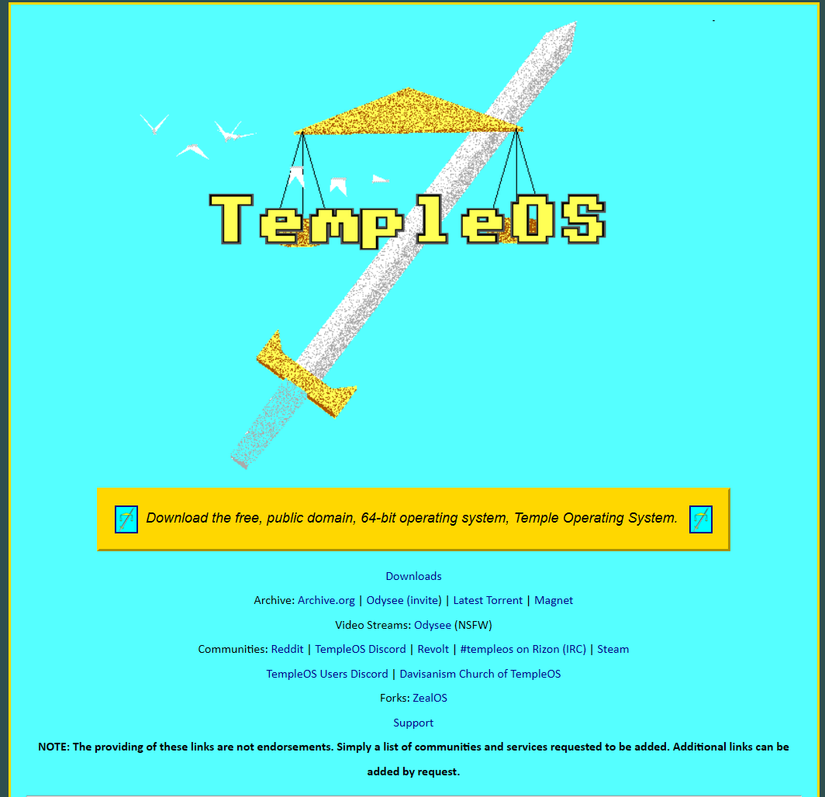It's not all that often you get to play around with an operating system as unique as TempleOS. Developed by one man, Terry A. Davis, TempleOS is a 64-bit open-source operating system that, while on the surface, may seem simplistic and messy, is actually a very impressive amalgamation of one man's inspiration from god, combined with great programming prowess, and ultimately forever tied with tragedy. It's definitely the weirdest OS I've ever tried on my PC, but I don't regret it in the slightest.
A life's work
Terry A. Davis' magnum opus

Terry's story is a complicated one, but as far as his software goes, TempleOS was developed as a way to get back to his roots as someone who very much enjoyed the Commodore 64. He was a very adept computer programmer, but as he began to struggle with schizophrenia in the mid-90s, his mental state began to deteriorate, and he began to believe that government agencies were spying on him, and that God was relaying messages to him through the code he created.
Throughout the 2000s and into the 2010s, Terry iterated on his OS project once called J Operating System, eventually coined TempleOS in 2013. Terry would eventually pass away tragically in 2018, and while his legacy is marred by controversy, TempleOS is a fascinating piece of software, one which I hadn't actually looked at myself before.
It's an OS that combines so many rare features that you don't see every day: it's ring-0 only, non-networked, multithreaded, and fits in under 100,000 lines of code. Not to mention it uses its own programming language, HolyC, which is a derivative of the C programming language. Terry frequently claimed that he was God's chosen programmer, and that this piece of software was the temple he was instructed to build.
Overstimulating
In a fantastic way
I will admit, I did attempt to run TempleOS on my bare hardware, first on a modern ASUS Zenbook Duo, then my main workstation, on a spare partition. I didn't manage to get it booted in a timely fashion, so I turned to good old virtualization, which is more than enough for experiencing what TempleOS has to offer.
Upon booting, you're greeted with an option to install directly to disk, or run as a live environment from the boot media. I chose the former, as I was just working in a virtual environment anyway. The first screen actually remarks that a virtual machine is how Terry himself had to run the OS, as it didn't boot on the hardware he had. This boot loader, and by extension, the kernel and graphics library, were all programmed by Terry himself.
After everything is installed, and you boot back into the OS, you're greeted with the option to take a tour. I wasn't going to say no, of course. The tour consists of how to use the operating system, everything from the file system to debugging your own programs. The Test Suite is where things got really interesting.
Entering the Test Suite will cause a series of demos to play, ranging from 2D top-down games to full 3D experiences, all cycled through automatically for a few seconds at a time to give you a taste of what TempleOS can do. During this time, the entire OS locked up and the Window Manager crashed. It had started printing characters to the screen when I moved my mouse, so I gave it a reboot and decided to explore a bit on my own.
An impractical, but impressive piece of software
The quirky, but charming features
TempleOS feels a lot more like a playground than it does any kind of practical operating system. The "nongames" included aren't practical either, but they are quite interesting. A budgeting program, a random vocabulary quiz generator, a logic tool, and a piano you can write music with, controlled by your keyboard.
I know next to nothing about the C programming language, let alone HolyC, so I'm flying completely blind outside the safety of the main menu screen. TempleOS and its RedSea file system completely exposes all the code it runs on to you, so it's possible to make essentially any change you want within the OS itself, reboot, and continue to tinker as you wish.
TempleOS is an absolute trip
While Terry is no longer with us, his software certainly is, and it's so fascinating to peruse through. TempleOS and all of its code has been transferred to the public domain, completely open-source, and definitely worth a try. It has developed a cult-like following, with vibrant Discord and Reddit communities dedicated to Terry's work. It serves as a great inspiration to budding programmers who want to get their feet wet, not just in the programming of operating systems, but any kind of software.
.png)











 English (US) ·
English (US) ·